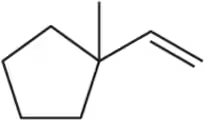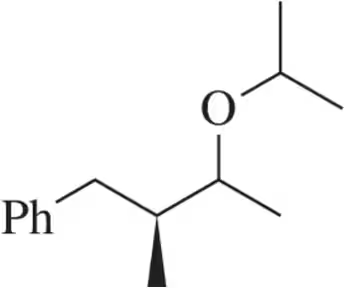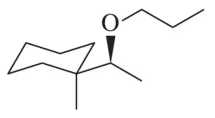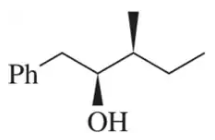 Back
BackProblem 42
Ethers can be synthesized by substituting ethanol for water in the acid-catalyzed hydration reaction. Suggest an arrow-pushing mechanism which accounts for the formation of the ethyl ether under these conditions.
Problem 43
When combining isoprene equivalents, IPP is never the electrophile. Why might this be? What is special about DPP that allows it to function better as an electrophile? [Draw the carbocation that each becomes.]
Problem 44
Suggest a mechanism for the synthesis of farnesol beginning with IPP and DPP.
Problem 45(e)
Which of the following carbocations would you expect to rearrange? If you expect rearrangement, draw the carbocation you expect to form and the mechanism by which it will form.
(e)
Problem 45a
Which of the following carbocations would you expect to rearrange? If you expect rearrangement, draw the carbocation you expect to form and the mechanism by which it will form.
(a)
Problem 45b
Which of the following carbocations would you expect to rearrange? If you expect rearrangement, draw the carbocation you expect to form and the mechanism by which it will form.
(b)
Problem 45c
Which of the following carbocations would you expect to rearrange? If you expect rearrangement, draw the carbocation you expect to form and the mechanism by which it will form.
(c)
Problem 45e
Which of the following carbocations would you expect to rearrange? If you expect rearrangement, draw the carbocation you expect to form and the mechanism by which it will form.
(e)
Problem 45f
Which of the following carbocations would you expect to rearrange? If you expect rearrangement, draw the carbocation you expect to form and the mechanism by which it will form.
(f)
Problem 46a
Provide a mechanism for the following reactions occurring with rearrangement.
(a)
Problem 46b
Provide a mechanism for the following reactions occurring with rearrangement.
(b)
Problem 47
The hydration of three C5H10 alkene isomers can give 2-methylbutan-2-ol. Draw them.
Problem 48
Our wayward chemist from Assessment 8.23 suggested the following stepwise mechanism for a hydride shift. Show this mechanism on a reaction coordinate diagram to illustrate why the concerted mechanism is more likely. Justify the picture you have drawn.
Problem 50a(i)
Predict the products you would get when the following alkenes react under the following conditions: (i) H2SO4 , H2O
(a)
Problem 50a(ii)
Predict the products you would get when the following alkenes react under the following conditions: (ii) 1. Hg(OAc)2 , H2O , 2. NaBH4
(a)
Problem 50c
Predict the products you would get when the following alkenes react under the following conditions: (i) H2SO4, H2O and (ii) 1. Hg(OAc)2, H2O , 2. NaBH4
(c)
Problem 50d
Predict the products you would get when the following alkenes react under the following conditions: (i) H2SO4, H2O and (ii) 1. Hg(OAc)2, H2O , 2. NaBH4
(d)
Problem 51
Provide an arrow-pushing mechanism, accounting also for the stereochemical outcome, of the first step (oxymercuration) of the three reactions in Figure 8.63.
Problem 51a
Provide an arrow-pushing mechanism, accounting also for the stereochemical outcome, of the first step (oxymercuration) of the three reactions in Figure 8.63.
Problem 52
Which is more stable, a carbocation or a mercurinium ion? How do you know?
Problem 53a
Oxymercuration–reduction, like acid-catalyzed hydration, can be modified to synthesize ethers. Suggest an alkene and the appropriate reaction conditions to synthesize the following ethers.
(a)
Problem 53b
Oxymercuration–reduction, like acid-catalyzed hydration, can be modified to synthesize ethers. Suggest an alkene and the appropriate reaction conditions to synthesize the following ethers.
(b)
Problem 54a
Predict the products you would get when the following alkenes undergo (i) hydroboration–oxidation (1. BH3 2. NaOH, H2O2 or (ii) oxymercuration–reduction [1. Hg(OAc)2, H2O 2. NaBH4].
(a)
Problem 54b(ii)
Predict the products you would get when the following alkenes undergo (ii) oxymercuration–reduction [1. Hg(OAc)2 , H2O 2. NaBH4 ].
(b)
Problem 55c
Suggest an alkene to undergo hydroboration–oxidation (1. BH3 2. NaOH, H2O2) to give exclusively the alcohols shown. Pay close attention to the relative (but not absolute) stereochemical outcome.
(c)
Problem 55d
Suggest an alkene to undergo hydroboration–oxidation (1. BH3 2. NaOH, H2O2) to give exclusively the alcohols shown. Pay close attention to the relative (but not absolute) stereochemical outcome.
(d)
Problem 55e
Predict the major product(s) of the following elimination reactions, paying close attention to the stereochemical outcome of the reactions.
(e)
Problem 56
Unlike hydroboration–oxidation, the addition of H2O catalyzed by H3O+ is not stereospecific. Thinking carefully about the mechanism of the reaction, give two reasons why.
Problem 57
The first step of oxymercuration–reduction is stereospecific, and yet this fact wasn't emphasized in that discussion. Show the stereospecificity of the first step for the following alkene and then explain why the stereospecificity becomes unimportant after the second step.
Problem 58a
Calculate the index of hydrogen deficiency for the following molecular formulas and structures.
(a)

























